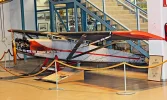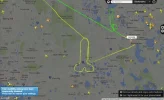Joku puusilmä lähes törmäsi liitovarjon hinausvaijeriin..
Lentosäännöt ne on Ruotsissakin, ja koneen pilotti ei niistä piitannut.
Lähtökohta on, että lentopaikkaa (myös korpikenttää) lähestyttäessä hyvissä ajoin ilmaistaan omat aikomukset, esim. xxxx liikenne, Oscar-Kilo-Romeo lähestyy etelästä, arvio laskukierrokseen 5 min. Nyt jaksolla oleva hinausmiehistö ilmoittaa, varjohinaus, vaijeri ja varjo ilmassa. Mitään vaaratilannetta ei olisi syntynyt.
Nyt kaveri tööttäsi tulemaan suoraan varjon alta, puhtaasti tuurilla ohitti vaijerin.

Videon YouTube-esittelytekstissä on linkki tutkijalautakunnan raporttiin. Saabin pilotti oli 65-vuotias 3093 tunnin lentokokemuksella. Saabisti kertoo, ettei vastavalon takia nähnyt varjoliitäjää eikä ollut tietoinen paikalla harjoitettavasta varjoliitotoiminnasta. Paikka on vinssillä varustettu purjelentopaikka. Mahdollisesti purjelentokausi on Ruotsissa lokakuun puolivälissä takanapäin ja siksi katsoi voivansa lentää paikan yli? Tutkijalautakunta päätyy toteamaan, ettei köyteen törmääminen olisi olut vakava "The overall conclusion from the study is that no serious consequences would have occurred in a collision between the aircraft and the paraglider line."
"SUMMARY
An aircraft of the model SAAB MFI 15 took off from Sundbro, Uppsala, for a
VFR flight to Johannisberg, Västerås. Shortly thereafter began winching of a
paraglider from Härkeberga, located along the aircraft's route.
At the final stage of the winching, at about 350 meters altitude, the paraglider
pilot saw an airplane coming straight at him at a slightly lower altitude. The
aircraft passed below the paraglider a few seconds later without colliding. The
height difference was estimated by the paraglider pilot to about 50 feet and the
distance to the line was 1 to 3 meters.
The pilot of the aircraft never perceived the event. The map data that the pilot
used - and which is the most widely used in general aviation - had no special
marking of the paragliding activities at Härkeberga. Neither the paraglider nor
the aircraft flew at altitudes implying contact with controlled airspace.
In order to investigate the possible consequences, SHK commissioned a study
of a hypothetical sequence of events where the aircraft collides with the line.
The overall conclusion from the study is that no serious consequences would
have occurred in a collision between the aircraft and the paraglider line.
The incident was caused by the pilot's flight maps lacking data on paragliding
activities at Härkeberga which meant that the flight could not be planned and
carried out safely. Contributing factor has been reduced visibility due to
backlight conditions.
Recommendations
None."
http://www.havkom.se/assets/reports/English/RL_2014_15_1.pdf







